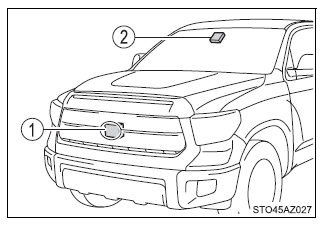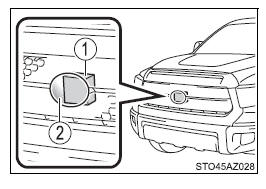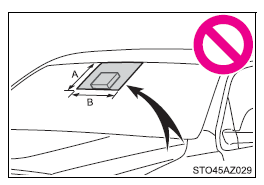The Toyota Safety Sense P consists of the following drive assist
systems and contributes to a safe and comfortable driving experience:
| WARNING ■Toyota Safety Sense P
The Toyota Safety Sense P is designed to operate under the assumption
that the driver will drive safely, and is designed to help reduce the
impact to
the occupants and the vehicle in the case of a collision or assist the
driver in
normal driving conditions.
As there is a limit to the degree of recognition accuracy and control
performance
that this system can provide, do not overly rely on this system. The
driver is always responsible for paying attention to the vehicle's
surroundings
and driving safely. |
Vehicle data recording
The pre-collision system is equipped with a sophisticated computer
that will record certain data, such as:
- Accelerator status
- Brake status
- Vehicle speed
- Operation status of the pre-collision system functions
- Information (such as the distance and relative speed between your
vehicle and the vehicle ahead or other objects)
- Images from the camera sensor (available only when the pre-collision
braking function or the pre-collision brake assist function was
operating)
The pre-collision system does not record conversations, sounds or
images of the inside of the vehicle.
- Data usage
Toyota may use the data recorded in this computer to diagnose
malfunctions, conduct research and development, and improve
quality.
Toyota will not disclose the recorded data to a third party except:
- With the consent of the vehicle owner or with the consent of the
lessee if the vehicle is leased
- In response to an official request by the police, a court of law or
a
government agency
- For use by Toyota in a lawsuit
- For research purposes where the data is not tied to a specific
vehicle or vehicle owner
- Recorded images can be erased using a specialized device.
The image recording function can be disabled. However, if the function
is disabled, data from when the pre-collision system operates
will not be available.
Sensors
Two types of sensors, located behind the front grille and windshield,
detect information necessary to operate the drive assist systems.
- Radar sensor
- Camera sensor

| WARNING ■To avoid malfunction of the radar sensor
Observe the following precautions.
Otherwise, the radar sensor may not operate properly, possibly leading
to
an accident resulting in death or serious injury.
- Keep the radar sensor and front grille emblem clean at all
times.
- Radar sensor
- Front grille emblem

If the front of the radar sensor or the
front or back of the front grille emblem
is dirty or covered with water droplets,
snow, etc., clean it.
Clean the radar sensor and front grille
emblem with a soft cloth so you do not
mark or damage them. |
WARNING
- Do not attach accessories, stickers (including transparent
stickers) or
other items to the radar sensor, front grille emblem or surrounding
area.
- Do not subject the radar sensor or surrounding area to a strong
impact.
If the radar sensor, front grille, or front bumper has been
subjected to a
strong impact, have the vehicle inspected by your Toyota dealer.
- Do not disassemble the radar sensor.
- Do not modify or paint the radar sensor, front grille emblem or
surrounding
area.
- If the radar sensor, front grille, or front bumper needs to be
removed and
installed, or replaced, contact your Toyota dealer.
■To avoid malfunction of the camera sensor
Observe the following precautions.
Otherwise, the camera sensor may not operate properly, possibly leading
to
an accident resulting in death or serious injury.
- Keep the windshield clean at all times.
- If the windshield is dirty or covered with an oily film,
water droplets,
snow, etc., clear the windshield.
- If a glass coating agent is applied to the windshield, it
will still be necessary
to use the windshield wipers to remove water droplets, etc. from
the area of the windshield in front of the camera sensor.
- If the inner side of the windshield where the camera sensor
is installed
is dirty, contact your Toyota dealer.
- Do not attach objects, such as stickers,
transparent stickers, and so forth, to the
outer side of the windshield in front of
the camera sensor (shaded area in the
illustration).

-
From the top of the windshield to
approximately 0.4 in. (1 cm) below
the bottom of the camera sensor
-
Approximately 7.9 in. (20 cm) (Approximately 4.0 in.
[10 cm] to the
right and left from the center of the camera sensor)
|
WARNING
- If the part of the windshield in front of the camera sensor is
fogged up or
covered with condensation or ice, use the windshield defogger to
remove
the fog, condensation or ice.
- If water droplets cannot be properly removed from the area of
the windshield
in front of the camera sensor by the windshield wipers, replace the
wiper insert or wiper blade.
If the wiper inserts or wiper blades need to be replaced, contact
your
Toyota dealer.
- Do not attach window tinting to the windshield.
- Replace the windshield if it is damaged or cracked.
If the windshield needs to be replaced, contact your Toyota dealer.
- Do not get the camera sensor wet.
- Do not allow bright lights to shine into the camera sensor.
- Do not dirty or damage the camera sensor.
When cleaning the inside of the windshield, do not allow glass
cleaner to
contact the lens. Also, do not touch the lens.
If the lens is dirty or damaged, contact your Toyota dealer.
- Do not subject the camera sensor to a strong impact.
- Do not change the installation position or direction of the
camera sensor or
remove it.
- Do not disassemble the camera sensor.
- Do not modify any components of the vehicle around the camera
sensor
(inside rear view mirror, etc.) or ceiling.
- Do not attach any accessories that may obstruct the camera
sensor to the
hood, front grille or front bumper. Contact your Toyota dealer for
details.
- If a surfboard or other long object is to be mounted on the
roof, make sure
that it will not obstruct the camera sensor.
- Do not modify the headlights or other lights.
|
|